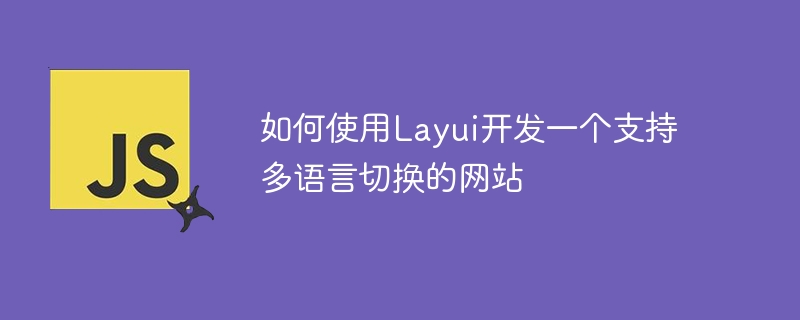

How to use Layui to develop a website that supports multi-language switching
With the development of globalization, more and more websites need to support multi-language switching to meet different needs User needs. Layui is a very popular front-end framework that provides a series of easy-to-use components and tools that can help us quickly develop beautiful websites. This article will introduce how to use Layui to develop a website that supports multi-language switching, and provide specific code examples.
First of all, we need to introduce Layui related files into the web page. You can download the Layui compressed package from the official website, and after decompressing it, copy the relevant files (such as layui.js, layui.css, etc.) to the corresponding directory in the project.
Next, add a drop-down menu for language switching in the HTML file for selecting different languages. You can use Layui's form component to achieve this function. The sample code is as follows:
<div class="layui-form" id="language-form">
<div class="layui-inline">
<label class="layui-form-label">语言切换:</label>
<div class="layui-input-inline">
<select name="language" lay-verify="required" lay-filter="language">
<option value="zh">中文</option>
<option value="en">English</option>
<!-- 其他语言选项 -->
</select>
</div>
</div>
</div>In this code, we use a select element as a drop-down menu, specify the required verification through the lay-verify attribute, and specify the callback that triggers the language switching event through the lay-filter attribute. function.
Next, we need to write some JavaScript code to implement the language switching function. The sample code is as follows:
layui.use(['form', 'element'], function(){
var form = layui.form;
var element = layui.element;
// 监听语言切换的选择事件
form.on('select(language)', function(data){
var language = data.value;
// 根据选择的语言加载不同的语言包
if(language === 'zh'){
// 加载中文语言包
layui.config({
base: 'js/layui/lang/',
version: true
}).extend({
lang: 'zh'
});
}else if(language === 'en'){
// 加载英文语言包
layui.config({
base: 'js/layui/lang/',
version: true
}).extend({
lang: 'en'
});
}
});
});In this code, we use Layui's form module and element module. Listen to the selection event of language switching through the form.on method, and load different language packages according to the selected language.
Finally, we need to write language pack files for multiple different language versions. Taking Chinese and English as an example, create a zh.js and en.js file respectively. The sample code is as follows:
zh.js:
layui.define([], function(exports) {
exports('zh', {
hello: '你好',
world: '世界'
});
});en.js:
layui.define([], function(exports) {
exports('en', {
hello: 'Hello',
world: 'World'
});
});In these two language pack files, we use the layui.define method to define a module and output an object, which contains key-value pairs of different languages.
Through the above steps, we can use Layui to develop a website that supports multi-language switching. When the user selects a different language, the text content of the website will automatically switch to the corresponding language version.
Summary: Websites that support multi-language switching can provide a better user experience and meet the needs of different users. Using Layui to develop such a website can quickly and easily implement the language switching function. By introducing Layui related files, adding a drop-down menu for language switching, writing JavaScript code and language pack files, we can easily develop a website that supports multi-language switching.
The above is the detailed content of How to use Layui to develop a website that supports multi-language switching. For more information, please follow other related articles on the PHP Chinese website!
 How to make charts and data analysis charts in PPT
How to make charts and data analysis charts in PPT
 Android voice playback function implementation method
Android voice playback function implementation method
 AC contactor use
AC contactor use
 The difference between vscode and visual studio
The difference between vscode and visual studio
 The difference between Java and Java
The difference between Java and Java
 Introduction to hard disk interface types
Introduction to hard disk interface types
 nagios configuration method
nagios configuration method
 How to delete a folder in linux
How to delete a folder in linux